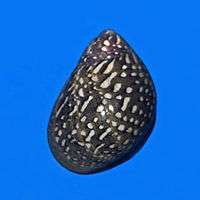Neritina virginea
| Neritina virginea Temporal range: Miocene - Recent | |
|---|---|
 | |
| Shells of Neritina virginea | |
| Scientific classification | |
| Kingdom: | Animalia |
| Phylum: | Mollusca |
| Class: | Gastropoda |
| (unranked): | clade Neritimorpha clade Cycloneritimorpha |
| Superfamily: | Neritoidea |
| Family: | Neritidae |
| Genus: | Neritina |
| Species: | N. virginea |
| Binomial name | |
| Neritina virginea (Linnaeus, 1758) | |
| Synonyms[2] | |
| |
Neritina virginea, the Virgin Nerite, is a species of sea snail, a marine gastropod mollusk in the family Neritidae.[3]
Distribution
This species is widespread from the Bahamas, Bermuda, Cuba, West Indies, Greater and Lesser Antilles, Dominica, Puerto Rico, Central America (Panama, Guatemala, Costa Rica), Brazil, Venezuela, Suriname, Colombia, Mexico, Texas and Florida.[2][4][5]
Habitat
Neritina virginea can withstand large changes in salinity and therefore may live in freshwaters, in marine and in brackish waters. These sea snails occur in rivers and streams, in estuaries and in the sea, on sand, silt and stones, brackish ponds and mangroves.[2][6]

Description
Shells of Neritina virginea can reach an average size of 6–25 millimetres (0.24–0.98 in).[4] These colorful grass-flat snails show extremely variable pattern and color. They are semiglobular, with 3 or 4 whorls. The aperture is oval, with thin lips. Operculum is usually black. The polished shell surface may be black, grey or white, yellowish, olive, red and purple, with various stripes or waves, spots and lines.[7][8]
Biology
They are herbivorous (algae) and diadromous. They are involved in massive upstream migrations.[2][9]
_(8577779994).jpg)
References
- ↑ Paleobiology Database
- 1 2 3 4 IUCN Red List
- ↑ Neritina virginea (Linnaeus, 1758). Retrieved through: World Register of Marine Species on 5 May 2010.
- 1 2 Hardy's Internet Guide to Marine Gastropods
- ↑ (German) Starmühlner F. von (1988). "Ergebnisse der Österreichisch-Französischen Hydrobiologischen Mission 1979 nach Guadeloupe, Dominica und Martinique (Kleine Antillen). Teil II: Beiträge zur Kenntnis der Süß- und Brackwassermollusken von Guadeloupe, Dominica und Martinique". Annalen des Naturhistorischen Museums in Wien Serie B, 90: 221-340. PDF.
- ↑ Distribution of the mangrove gastropods Neritina virginea (Neritidae) and Littoraria angulifera (Littorinidae) within the Colombian Caribbean Darién Ecoregion
- ↑ Susan B. Rothschild Beachcomber's Guide to Gulf Coast Marine Life: Texas, Louisiana, Mississippi
- ↑ R. Tucker Abbott, Percy A. Morris A Field Guide to Shells: Atlantic and Gulf Coasts and the West Indies
- ↑ JUAN F. BLANCO AND FREDERICK N. SCATENA Floods, Habitat Hydraulics and Upstream Migration of Neritina virginea (Gastropoda: Neritidae) in Northeastern Puerto Rico
Bibliography
- Blanco-Libreros JF, Arroyave-Rincón A. - Predator damage and shell size on the diadromous snail Neritina virginea (Gastropoda: Neritidae) in the Mameyes River, Puerto Rico
- Cordeiro, J. & Perez, K. 2012. Neritina virginea. The IUCN Red List of Threatened Species 2012: e.T189436A1925495.
- Pointier J.P. (ed.). (2015). Freshwater molluscs of Venezuela and their medical and veterinary importance. Harxheim: ConchBooks. 228 pp
- Turgeon, D. D., A. E. Bogan, E. V. Coan, W. K. Emerson, W. G. Lyons, W. Pratt, et al. (1988) Common and scientific names of aquatic invertebrates from the United States and Canada: mollusks, American Fisheries Society Special Publication 16
- Turgeon, D. D., J. F. Quinn, Jr., A. E. Bogan, E. V. Coan, F. G. Hochberg, W. G. Lyons, et al. (1998) Common and scientific names of aquatic invertebrates from the United States and Canada: Mollusks, 2nd ed., American Fisheries Society Special Publication 26
